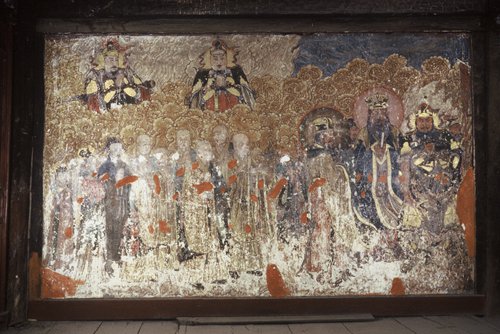
A mural at the Pingwu Bao'en Temple (Photo/Courtesy of Ren Yin)
Originally, the Pingwu Bao'en Temple was built to rival the beauty and grandeur of the Forbidden City, but it was never wise to try and one up the emperor.
"The museum has dozens more gongdou (a type of corbel used exclusively in imperial structures) than the Forbidden City," said Ren Yin, associate curator of the Museum of Pingwu Bao'en Temple.
"Altogether, it has 10,000 dragon totems - which definitely puts it in the same class as an imperial household."
While Ren makes no effort to hide his pride, five centuries ago the temple builders wouldn't have dared to openly brag about their achievements.
Palace past
The temple is located in the northern mountains of Pingwu county about a five-hour bus ride from Chengdu, capital of Southwest China's Sichuan Province.
The all-wood building was built during the Ming Dynasty (1368-1644) in 1440 by a local official named Wang Xi, who was so impressed by the royal palace during a trip to Beijing that he decided to build one for himself.
"When he heard about it, the emperor was very angry at first, but then pardoned Wang due to his contributions to border stability," Ren told the Global Times on March 3.
"Wang then converted the palace into a Buddhist temple as a way of showing his gratitude for the emperor's mercy the emperor's mercy that's also how its name came from." Bao'en means "gratitude" in Chinese.
The temple covers an area of more than 27,800 square meters and features three main halls. From its bridges to roof decorations, the temple is a unique miniature replica of the Forbidden City located thousands of kilometers away. The relics in the compound, however, represent its role as a temple. These relics mainly consist of wooden Buddhist sculptures and amazingly exquisite murals in various states of disrepair.
Restoring the ruined
Three-fourths of the walls on the first floor of the Huayan and Daxiong halls are still covered in a layer of lime. Yet portions where the lime has been removed give visitors a rough idea of what the Buddhist paintings that are hidden underneath look like.
"Our experts used steamed buns and egg whites to remove the lime here as an experiment," said Ren, pointing to a small patch of the murals that could be seen under the lime.
According to Ren, the walls were painted over with lime during the Cultural Revolution (1966-76) when the local commune wanted to turn the temple into a barn. The statues of the Eighteen Arhats originally placed on either side of the halls were smashed to pieces and so were beyond repair.
It seems that the damage the Cultural Revolution caused to the relics was far more destructive than even the 8.0 magnitude 2008 Wenchuan Earthquake, in which more than 69,000 people lost their lives.
"The 2008 earthquake did little damage to the relics. The only thing that happened was that some of the wall sculptures became a bit detached from their bases. So we strengthened the frames that supported them," he said.
"But our craftsmen don't have the skills to restore the ruined murals," Ren explained.
"That's why the State Administration of Cultural Heritage (SACH) is sending professionals here to do the work. The project will start during the latter half of this year."
Currently, a team of professionals sent by the SACH are busy scanning the murals in order to build a digital archive for these precious relics.
Dying craftsmanship
"Restoration means using traditional craftsmanship and original materials, such as nanmu [a type of rare and expensive wood] and gold in the case of the Bao'en Temple, and avoiding randomly adding onto relics," said Shen Xinzhi, a 50-something local craftsman working for the temple, who also runs a store that sells wood carvings.
The shelves of his store are covered with beautiful hand-made sculptures that he carved himself.
Shen carries on the tradition of restoration craftsmanship handed down to him from his father, who passed away three years ago at the age of 94 after a lifetime spent restoring ancient relics.
Shen began working part time with his father when he was 15. Shen explained that traditional craftsmanship requires years of training and a solid foundation in art.
For instance, when restoring a dragon sculpture at the temple that had been broken in half, he had to make a support structure covered in cotton that would fit inside it, which is delicate work.
He also worked with the SACH to restore several "hands" on the temple's statue of the Thousand-Hand Bodhisattva.
"All restoration plans need to be examined and approved by the SACH," he said.
Shen told the Global Times that there aren't many young people who are willing to pursue restoration as a career because "it is tiring work that pays little. You have to really like it to stick with it."
Though he has relatives also working in restoration, he said many are the same age as he is, which leaves him worried that the lack of people to carry on the legacy will lead to its extinction.
Right now there are no resident relic experts at the temple, according to Ren, as many of the professionals only show up to work on projects.
"It's understandable. They, especially those who are talented, don't like to stay in a small town like this," Ren said. "But we're in urgent need of qualified restorers."


















































